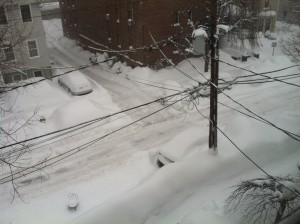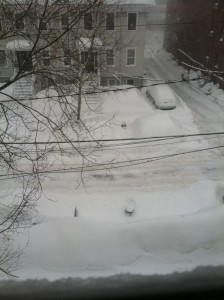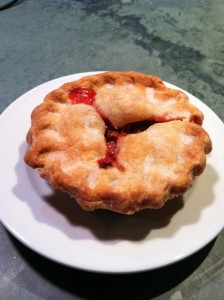Archive for category: Daily Life
“Spring” Semester in Cambridge, MA
Here was the view this morning from the window of our very pleasant apartment in Cambridge, MA. The gray horizontal strip in the middle is the road, the white mounds are cars, and the chair in the foreground is a parking spot that was saved before today’s snow. Fortunately, I don’t need to drive anywhere, so the snow has been memorable with being too great an inconvenience.
Pete Wehner on Suffering (and True Paradox)
Pete Wehner has a really nice post on suffering here, with some kind words on the chapter on suffering in True Paradox.
Violent and Nonviolent Protests
I had lunch yesterday with Randall Collins, a Penn sociologist who has written extensively about the “micro-sociology” of violence. (Our mutual friend Dave DeHuff, who runs the faculty-staff fellowship group at Penn, brought the three of us together). I would highly commend Randall’s blog essays, articles and books on these issues under any circumstances, but especially with the turmoil in Ferguson and Hong Kong.
I was particularly struck by two of Randall’s insights. The first is that violence is less likely when a protestor and police officer encounter one another face to face. Although a protester’s natural inclination is to flee, fleeing actually is often more dangerous than a face to face exchange, at least if the exchange could be kept relatively calm. It’s much harder to attack someone when you see them face to face. This seems to me to reflect an implicit recognition, even in the most hostile of circumstances, that each of us is made in the image of God and is therefore precious.
Randall also pointed out that when protesters damage or destroy property, they usually target property in their own neighborhood. This may explain the seeming incongruity of protesters damaging businesses that serve their own community, which often seems counterproductive. But protestors tend to feel most comfortable in their own neighborhood, and their neighborhood is they place whose injustice upsets them most.
Chinese Manners
During my stay in Hong Kong last week, I got several lessons in Chinese manners, usually after I’d managed to mix things up. I assumed that the two sets of chopsticks at a formal Chinese dinner were there so that a backup would be available if necessary, not realizing that each had a specific role (a bit like the salad and dinner forks I’m a little more familiar with). And after handing out a few business cards, I learned that the proper etiquette is to present your card with both hands, rather than just one.
Trickiest for me is the rule that, if you cross your legs while sitting down, it’s impolite to point a shoe toward the person or persons opposite you. Pointing your shoe is a sign of disrespect. If you happen to watch the video of my lecture “Is Justice Possible?” at Hong Kong University, you’ll notice that I paid nearly as much attention to my feet as to the very challenging and interesting questions. I finally concluded the best bet was simply not to cross my legs.
Beijing
I managed to see the full-range of Beijing skies in my very packed two and a half day visit (which has just come to an end): the sky was almost perfectly blue on Monday; yesterday the sky was still blue, with just a fringe of yellow on the horizons; today it was blocked by an impenetrable white haze of smog and mist. A student I met said her dormitory room was unusually cold last week because the supply of coal used to heat the dorms was cut off during the APEC meetings—a small part of the price of the blue sky.
Having spent the morning yesterday at the Forbidden City, which is right next to China’s current governmental buildings, it occurred to me that Beijing’s pollution falls on the elite as well as the poor. Perhaps this will make Chinese leaders more sensitive to the health risks and other consequences of the pollution than they would be if the Chinese factories were further removed from the capital city.
The Forbidden City itself is quite beautiful, and was quite mobbed. It was originally built in the early 1400s, during the Ming Dynasty, and consists of a series of highly decorated buildings progressing from an outer court where the Emperor’s ministers lived to an inner court where he and his inner circle lived. I seemed to be one of the few Westerners there; many of the men who had come had notably calloused hands (which I noticed as we all jostled for position at the windows of the palace buildings), which seemed to confirm my host’s comment that the Forbidden City is especially popular with traditionalists and men and women from the Chinese countryside.
Hong Kong (and Beijing)
Sooner or later, every conversation here in Hong Kong turns to the Occupy movement. During my five days here, I’ve quickly found that reactions to the movement are much more complicated than I imagined before I came. The movement is a protest against a change in the process for selecting the leading official in Hong Kong that was touted by Beijing as enhancing democracy. As I understand it, the 1200 person election committee, which consists of representatives from various Hong Kong constituencies will select two or three nominees. Hong Kong’s citizens will then vote for their preferred candidate among the nominees. Supporters of the movement have set up tents in three different parts of Hong Kong, blocking roads in the heart of the city. Even within the church, views of the civil disobedience are sharply divided. Some feel it that it is inappropriate to undercut secular authority, while others view the protests as a justified challenge, often by analogy to the Civil Rights movement and other civil disobedience campaigns.
Whatever one’s views of Occupy, it has become a major tourist attraction. Yesterday, when I walked through the tents—and umbrellas, a symbol of the movement—of the main site in downtown Hong Kong, there were dozens of tourists taking pictures with their phones. More on the movement in the coming days.
In a few hours, I fly to Beijing for the last three days of this trip. Last week, Beijing’s skies were uncharacteristically clear and blue, as a result of restrictions put in place for President Obama’s visit. (The blue skies are described as APEC Blue in the press– a reference to the meetings that brought Obama and other leaders to Beijing). Apparently, the smog is now rolling back in, just in time for my arrival.
A New York Times Testimonial
A fascinating essay in the New York Times on Sunday by a woman who lost her Christian faith before moving to New York begins with a lovely description of what it’s like to plunge into the ocean for the first time each summer, and describes the experience as the “best way I know to belong again, body and soul, to some part of the planet, not just the city, not just the job.”
The essay reads remarkably like what Christians call a “testimony”—a story about how a person’s life has changed as a result of adopting a particular set of beliefs about how the world works. Christian testimonies generally focus on how repenting and embracing Jesus has reconciled them to God and transformed their life.
One of the perhaps counterintuitive arguments I make in True Paradox (not yet out—but due out early next month) is that testimonies—or testimonials—are important evidence of whether a set of beliefs is true. Not decisive, but important. If a set of beliefs helps a person to better navigate the world, this is evidence that the beliefs could be true. Similarly, if adherents to a set of beliefs cannot point to testimonials, this is evidence the beliefs are not true.
The New York Times essay is an example of an increasing tendency for atheists to produce their own testimonials. Many, like this one, emphasize the joy the writer gets from realizing she is part of something much larger than herself, such as the web of nature. One question I always have with this kind of testimonial is whether it is sustainable, given that there is so much brokenness and horror in the world. What resources does a set of beliefs like this one provide for dealing with the ugliness of the world?
But the increasing prevalence of atheist testimonials is, in my view, evidence of a recognition that if our understanding of the world is true, it will make sense emotionally as well as intellectually. It will help us to navigate both the big things in life and the little ones.
Christianity has a long history of testimonials from those who have been lifted up from darkness. Who were once blind, as John Newton put it in “Amazing Grace,”but now see. It will be interesting to see if comparable atheist testimonials emerge in the coming years.
American Pies
Many years ago, my wife and I stumbled across a memorable article called “The Great American Pie Expedition” in the New Yorker. The article, which recounted the author’s road trip searching out cafes, bakeries and restaurants that made great pies, inspired us to take sometimes lengthy side trips hoping to share in the fruit of her discoveries. In Uniontown, Pennsylvania the owners of a small diner told us: yes, they remembered the author, a “divorced lady” who stopped by several times. In Oseo, Wisconsin, the pies helped us endure the constant crying of our then-11 month old, who turned out to have his first ear infection.
I’d trade even the very best of them for the pies at Greenwich Village Café & Bakery in Greenwich (pronounced “Green-witch”), New York, which my wife happened upon during our month-long stay in a one bedroom apartment in a converted barn thirty miles east of Saratoga. The raspberry pie is tops in my book, the blueberry a close second. We’ve had an excellent peach pie, and there are blackberry, banana cream, cranberry walnut and twenty others as well. My favorite word in “The Great American Pie Expedition” is “bilious,” which is how I too feel after weeks of wonderful pies. But for those who have world enough and time, and happen to be in this neighborhood, I’d recommend trying every pie Greenwich Village Café & Bakery has to offer.
Summer Solstice
Maybe something is wrong with my stars, but the summer solstice always leaves me feeling off balance. Although there are a lot of things I don’t love about summer, I do love the lengthening days, which leave more time to sit on the back porch sipping a glass of wine, waiting for the deer (a doe and a fawn, this summer) to make their early evening appearance. Yet the solstice always seems to come just as summer gets going. It seems like the days should still be expanding. The longest day shouldn’t have come last weekend. It should be four or five weeks from now.



